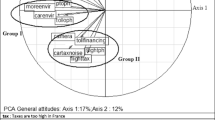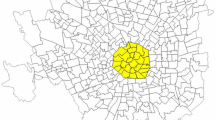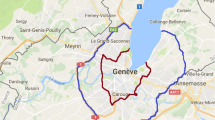Abstract
This paper shows that road pricing can be regressive, progressive or neutral, and refutes the generalised idea that road pricing is always regressive. The potential distributional impacts of a road pricing scheme are assessed in three English towns. It is found that impacts are town specific and depend on where people live, where people work and what mode of transport they use to go to work. Initial impacts may be progressive even before any compensation scheme for losers is taken into account. When the situation before the scheme is implemented is such that majority of drivers entering the area where the scheme would operate come from households with incomes above the average, it can be expected that, once the scheme is implemented, these drivers coming from rich households will continue to cross the cordon and will be prepared to pay the charge. In such a case the overall effect will be that on average, rich people will pay the toll and poor people will not.
Similar content being viewed by others
References
Acts of Parliament (1999) Greater London Authority Act 1999 c. 29, London: HMSO. http://www.hmso.gov.uk/acts/acts1999/19990029.htm.
Acts of Parliament (2000) Transport Act 2000 c. 38. December 2000. http://www.hmso.gov.uk/acts/acts2000/20000038.htm.
Blow L & Crawford I (1997) The distributional effects of taxes on private motoring. Commentary No. 65. London: The Institute for Fiscal Studies.
Button K & Verhoef E (1998) Pricing, Traffic Congestion and the Environment. Lincolnshire: Edward Elgar.
CASWEB, Web-based Interface to Census Area Statistics. http://census.ac.uk/casweb/.
Census Dissemination Unit (CDU), MIMAS, Manchester Computing Service. http://www.mimas.ac.uk/.
Commission for Integrated Transport (2002) Congestion Charging in the UK, December 20. http://www.cfit.gov.uk/congestioncharging/factsheets/uk/index.htm.
Commission of the European Communities, International Monetary Fund, Organisation for Economic Co-operation and Development, United Nations, and World Bank (1993) System of National Accounts 1993. Brussels, Luxembourg, New York, Paris, Washington DC.
Department of the Environment, Transport and the Regions (2000) Transport 2010: The 10 Year Plan. http://www.dft.gov.uk/trans2010/plan/index.htm.
Dodgson J, Young J & van der Veer J (2002) Paying for Road Use, Technical Report, A Report to the Commission for Integrated Transport, National Economic Research Associates (NERA), London, February. http://www.cfit.gov.uk/research/pfru/pdf/pfru-tech.pdf.
Durham County Council Press and Publicity Unit (2002) Country's First Town Centre Toad Toll Goes Live Next Week, September 26. http://www.durham.gov.uk.
Digitised Boundaries for Cambridge. Edinburgh UKBORDERS Facility, UKBORDERS, EDINA Data Centre, Digital Boundary Data (DBD) associated with the 1991 Census of Population, University of Edinburgh. http://www.edina.ac.uk/ukborders/.
Eliasson, J & Mattsson L-G (2001) Transport and location effects of road pricing. Journal of Transport Economics and Policy 35: 417-456.
Evans A (1992) Road congestion pricing? When is it a good policy? Journal of Transport Economics and Policy 26: 213-243.
Flowerdew A (1993) Urban Traffic Congestion in Europe: Road Pricing and Public Transport Demand, Research Report, The Economics Intelligence Unit, London, May.
Giuliano G (1994) Equity and fairness considerations of congestion pricing. In: Transportation Research Board (1994): 250-279.
Goodwin P (1989) The rule of three: A possible solution to the political problem of competing objectives for road pricing. Traffic Engineering and Control 30: 495-497.
Goodwin P (1990) How to make road pricing popular. Economic Affairs 10: 6-7.
Harrington W, Krupnick A & Alberini A (2001) Overcoming public aversion to congestion pricing. Transportation Research A 35: 87-105.
Ison S (2000) Local authority and academic attitudes to urban road pricing: A UK perspective. Transport Policy 7: 269-277.
ITS International (1999) Great expectations. ITS International, Jan–Feb: 37-39.
Johnson P, McKay S & Smith S (1990) The distributional consequences of environmental taxes. Commentary No. 23. London: The Institute for Fiscal Studies.
Jones P (1998) Urban road pricing: Public acceptability and barriers to implementation. In: Button and Verhoef (1998): 263-284.
Larsen O & Østmoe K (2001) The experience of urban toll cordons in Norway: Lessons for the future. Journal of Transport Economics and Policy 35: 457-471.
Layard R (1977) The distributional effects of congestion taxes. Economica 44: 297-341.
Lex Services (1998) Lex Report on Motoring: Driving for the Future. Bucks: Lex Service PLC, January.
Litman T (1996) Using road pricing revenue: Economic efficiency and equity considerations. Transportation Research Record 1558: 24-28.
Madsen B & Jensen-Butler C (2001) Modelling the Local Economic Impacts of Road Pricing, SØM Publication No. 46, Society, Economics & Environment Research Centre, Institute of Local Government Studies, Denmark, December. http://www.akf.dk/som/pdf/som46.pdf.
Ministry of Transport (1964) Road Pricing: The Economic and Technical Possibilities. London: HMSO.
Morrison SA (1986) A survey of road pricing. Transportation Research A 20: 87-97.
MVA (1995) The London Congestion Charging Research Programme, Final Report, Vol. 1: Text, Government Office for London, London: HMSO.
National Economic Development Office (1991) A Road User Charge: Londoner's Views, Report on Survey Findings, Harris/NEDO, London. Cited in Flowerdew (1993).
Newbery D (1990) Pricing and congestion: Economic principles relevant to pricing roads. Oxford Review of Economic Policy 6: 22-38.
Newbery D (1994) The case for a public road authority. Journal of Transport Economics and Policy 28: 235-253.
Newbery D & Santos G (1999) Road taxes, road user charges and earmarking. Fiscal Studies 20: 103-132.
Newbery D & Santos G (2002) Estimating urban road congestion costs. CEPR Discussion Paper 3176, Centre for Economic Policy Research, London.
Odeck J & Bråthen S (1997) On public attitudes toward implementation of toll roads — the case of Oslo toll ring. Transport Policy 4: 73-83.
Odeck J & Bråthen S (2002) Toll financing in Norway: The success, the failures and perspectives for the future. Transport Policy 9: 253-260.
Office for National Statistics (1998) New Earnings Survey, Part D: Analysis by Occupation, Newport, December.
Pigou A (1920) The Economics of Welfare. London: MacMillan and Co., Ltd.
RAC Foundation for Motoring (2003) RAC Report on Motoring Making the Most of Britain's Roads, London.
Richardson, H & Bae C-H (1998), The equity impacts of road congestion pricing. In: Button and Verhoef (1998): 247-262.
ROCOL Working Group (2000) Road Charging Options for London: A Technical Assessment. London: The Stationary Office, March.
Santos G, Newbery D & Rojey L (2001) Static versus demand-sensitive models and estimation of second-best cordon tolls: An exercise for eight English towns. Transportation Research Record 1747: 44-50.
Small K (1983) The incidence of congestion tolls on urban highways. Journal of Urban Economics 13: 90-111.
Small K (1992) Using the revenues from congestion pricing. Transportation 19: 359-381.
Small K & Gómez-Ibáñez J (1998) Road pricing for congestion management: The transition from theory to policy. In: Button and Verhoef (1998): 213-246.
Toh R (1992) Experimental measures to curb road congestion in Singapore: Pricing and quotas. Logistics and Transportation Review 28: 289-317.
report_mayor.shtml.
Transportation Research Board (1994) Curbing Gridlock: Peak Period Fees to Relieve Traffic Congestion, Special Report 242, Washington DC: National Research Council, National Academy Press.
Verhoef E, Nijkamp P & Rietveld P (1997) The social feasibility of road pricing: A case study for the randstad area. Journal of Transport Economic and Policy 31: 255-276.
Whitehead T (2002) Road user charging and business performance: Identifying the processes of economic change. Transport Policy 9: 221-240.
Author information
Authors and Affiliations
Corresponding author
Rights and permissions
About this article
Cite this article
Santos, G., Rojey, L. Distributional impacts of road pricing: The truth behind the myth. Transportation 31, 21–42 (2004). https://doi.org/10.1023/B:PORT.0000007234.98158.6b
Issue Date:
DOI: https://doi.org/10.1023/B:PORT.0000007234.98158.6b




